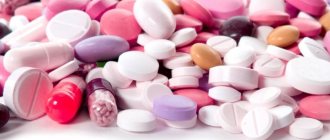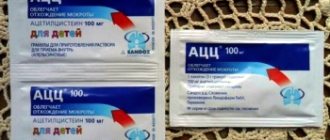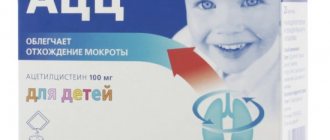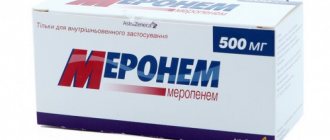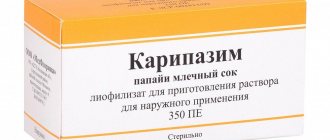pharmachologic effect
Mucolytic drug. Acetylcysteine is a derivative of the amino acid cysteine. It has a mucolytic effect, facilitates the discharge of sputum due to a direct effect on the rheological properties of sputum. The action is due to the ability to break the disulfide bonds of mucopolysaccharide chains and cause depolymerization of sputum mucoproteins, which leads to a decrease in sputum viscosity. The drug remains active in the presence of purulent sputum.
It has an antioxidant effect due to the ability of its reactive sulfhydryl groups (SH groups) to bind to oxidative radicals and thus neutralize them.
In addition, acetylcysteine promotes the synthesis of glutathione, an important component of the antioxidant system and chemical detoxification of the body. The antioxidant effect of acetylcysteine increases the protection of cells from the damaging effects of free radical oxidation, which is characteristic of an intense inflammatory reaction.
With the prophylactic use of acetylcysteine, there is a decrease in the frequency and severity of exacerbations in patients with chronic bronchitis and cystic fibrosis.
ACC hot drink honey-lemon 600 mg/3 g N6 powder for oral solution
Compound
active ingredient:
acetylcysteine;
1 sachet contains acetylcysteine 200 mg or 600 mg;
Excipients:
sucrose, ascorbic acid, sodium saccharin, lemon flavor, honey flavor.
Dosage form
Powder for oral solution.
Basic physical and chemical properties:
powder 200 mg
white to yellowish powder, possibly agglomerates, with a lemon/honey smell;
powder 600 mg
white to yellowish powder, possibly agglomerates, with a lemon/honey smell.
Pharmacotherapeutic group
Medicines used for coughs and colds. Mucolytic agents.
ATX code R05C B01.
Pharmacodynamics
Acetylcysteine (ACC) is a mucolytic expectorant that is used to thin sputum in diseases of the respiratory system accompanied by the formation of thick mucus. Acetylcysteine is a derivative of the amino acid cysteine. The mucolytic effect of the drug is of a chemical nature. Due to the free sulfhydryl group, acetylcysteine breaks the disulfide bonds of acidic mucopolysaccharides, which leads to depolymerization of sputum mucoproteins and a decrease in the viscosity of mucus and promotes expectoration and discharge of bronchial secretions. The drug remains active in the presence of purulent sputum.
Acetylcysteine also has antioxidant pneumoprotective properties, which is due to the binding of its sulfhydryl groups to chemical radicals and, thus, their neutralization. In addition, the drug helps to increase the synthesis of glutathione, an important factor in intracellular protection not only from oxidative toxins of exogenous and endogenous origin, but also from a number of cytotoxic substances. This feature of acetylcysteine makes it possible to effectively use it in case of paracetamol overdose.
Pharmacokinetics
After oral administration, acetylcysteine is quickly and completely absorbed and metabolized in the liver to form cysteine, a pharmacologically active metabolite, as well as diacetylcysteine, cystine, and then mixed disulfides. Bioavailability is very low - about 10%. The maximum concentration in blood plasma is achieved 1-3 hours after administration. Plasma protein binding - 50%. Acetylcysteine is excreted by the kidneys in the form of inactive metabolites (inorganic sulfates, diacetylcysteine).
The half-life is determined mainly by rapid biotransformation in the liver and is approximately 1 hour. In case of decreased liver function, the half-life is extended to 8 hours.
Indications
Treatment of acute and chronic diseases of the bronchopulmonary system, which require reducing the viscosity of sputum, improving its discharge and expectoration.
Contraindications
Hypersensitivity to acetylcysteine or other components of the drug.
Peptic ulcer of the stomach and duodenum in the acute stage, hemoptysis, pulmonary hemorrhage, severe exacerbation of bronchial asthma.
Interaction with other drugs and other types of interactions
Interaction studies were conducted with adults only.
The use of antitussives together with acetylcysteine can increase sputum stagnation due to a decrease in the cough reflex.
When used simultaneously with antibiotics such as tetracycline (except for doxycycline), ampicillin, amphotericin B, cephalosporins, aminoglycosides, they may interact with the thiol group of acetylcysteine, which leads to a decrease in the activity of both drugs. Therefore, the interval between the use of these drugs should be at least 2 hours. This does not apply to cefixime and loracarbef.
Activated carbon reduces the effectiveness of acetylcysteine.
It is not recommended to dissolve acetylcysteine in the same glass with other drugs.
With simultaneous administration of nitroglycerin and acetylcysteine, significant arterial hypotension and significant dilatation of the temporal artery were detected. If simultaneous use of nitroglycerin and acetylcysteine is necessary, patients should be monitored for arterial hypotension, which can be severe, and patients should also be warned about the possibility of headaches.
Acetylcysteine reduces the hepatotoxic effect of paracetamol.
There is a synergism between acetylcysteine and bronchodilators.
Acetylcysteine can be a cysteine donor and increase glutathione levels, which helps detoxify oxygen free radicals and certain toxic substances in the body.
Upon contact with metals or rubber, sulfides with a characteristic odor are formed, so glassware should be used to dissolve the drug.
Effect on laboratory tests.
Acetylcysteine may interfere with the colorimetric assay of salicylates and the determination of ketone bodies in urine.
Features of application
There are isolated reports of severe skin reactions (Stevens-Johnson and Lyell syndromes) when taking acetylcysteine, so if changes occur in the skin or mucous membranes, you should immediately stop using the drug and consult your doctor regarding further use.
It is recommended to use with caution in patients with a history of gastric and duodenal ulcers, especially in the case of concomitant use of other drugs that irritate the gastric mucosa.
Acetylcysteine affects histamine metabolism, so long-term therapy should not be prescribed to patients with histamine intolerance, as this may lead to symptoms of intolerance (headache, vasomotor rhinitis, itching).
Acetylcysteine should be prescribed with caution to patients with bronchial asthma due to the possible development of bronchospasm. If the contents of the sachet are spilled into a container while preparing the solution, the powder may become airborne and irritate the nasal mucosa, which may result in reflex bronchospasm. If bronchospasm occurs, treatment with acetylcysteine should be stopped immediately.
In patients with liver or kidney disease, acetylcysteine should be prescribed with caution to avoid the accumulation of nitrogen-containing substances in the body.
The use of acetylcysteine, mainly at the beginning of treatment, can cause dilution of bronchial secretions and increase its volume, especially in children under 2 years of age. If the patient is unable to cough up sputum effectively, postural drainage and bronchoaspiration are necessary.
The drug contains sucrose, so it should not be prescribed to patients with rare hereditary forms of fructose intolerance, sucrase-isomaltase deficiency or glucose-galactose malabsorption syndrome.
Information for patients with diabetes.
1 sachet of powder (200 mg acetylcysteine) contains 2.5 g of sucrose (0.21 bread units).
1 sachet of powder (600 mg acetylcysteine) contains 2 g of sucrose (0.17 bread units).
The ability to influence reaction speed when driving a vehicle or operating machinery
Does not affect.
Use during pregnancy or breastfeeding
During pregnancy and lactation, the use of acetylcysteine is possible only if the expected benefit to the mother outweighs the potential risk to the fetus or child.
Directions for use and doses
Adults and children over 14 years old
prescribe 400-600 mg of acetylcysteine per day in 1-3 doses.
Children aged 6 to 14 years
prescribe 400-600 mg per day, divided into 2-3 doses.
Children aged 2 to 6 years
prescribe 200-400 mg per day, divided into 2 doses.
It is recommended to take the drug after meals. Dissolve the contents of the bag while stirring in ½ glass of cold water, then add hot but not boiling water to a full glass. Stir and drink the liquid quickly after it has cooled to an acceptable temperature. The sequence of dissolving the powder (cold water is added first, and then hot) should not change. Additional fluid intake enhances the mucolytic effect of the drug.
The duration of treatment for chronic diseases is determined by the doctor depending on the nature and course of the disease. For acute uncomplicated diseases, use acetylcysteine for 4-5 days.
Children
Powder 200 mg
apply to children aged 2 years and older.
Powder 600 mg
Use in children over 14 years of age.
Overdose
There are no data on cases of overdose with oral administration of acetylcysteine.
Volunteers took 11.6 g of acetylcysteine per day for three months without experiencing any serious side effects. Oral doses of up to 500 mg acetylcysteine/kg/day were tolerated without symptoms of intoxication.
Symptoms
: nausea, vomiting, diarrhea. For children there is a risk of hypersecretion.
Therapy
: Treatment is symptomatic.
Adverse reactions
To describe the frequency of side effects, the following classification is used: very often (³ 1/10), often (³ 1/100, <1/10), infrequently (³ 1/1000, <1/100), rarely (³ 1/10000 , <1/1000), very rare (<1/10000).
From the cardiovascular system:
infrequently - tachycardia, arterial hypotension.
From the nervous system:
infrequently - headache.
From the skin:
uncommon - allergic reactions (itching, urticaria, rash, eczema, rash, angioedema).
From the hearing organs:
infrequently - ringing in the ears.
From the respiratory system:
rarely - shortness of breath, bronchospasm (mainly in patients with hyperreactivity of the bronchial system, associated with bronchial asthma), rhinorrhea.
From the digestive tract:
rarely - heartburn, dyspepsia, stomatitis, abdominal pain, nausea, vomiting, diarrhea, bad breath.
General violations:
infrequently - fever.
Isolated severe skin reactions (Stevens-Johnson and Lyell syndromes) have been reported. When using acetylcysteine, bleeding was very rarely reported and was most often associated with the development of hypersensitivity reactions. There have been cases of decreased platelet aggregation, but there is no clinical confirmation of this. Quincke's edema, facial swelling, cases of anemia, hemorrhage, anaphylactic reactions or even anaphylactic shock have been very rarely reported.
Best before date
3 years.
Storage conditions
Store at a temperature not exceeding 25 ° C.
Keep out of the reach of children.
Package
Powder 200 mg 3 g powder per sachet. 20 bags in a cardboard box.
Powder 600 mg 3 g powder per sachet. 6 bags in a cardboard box.
Vacation category
Over the counter.
Manufacturer
Salutas Pharma GmbH (series release).
Lindopharm GmbH (manufacturer in bulk, testing, packaging).
Zambon Switzeland Ltd (manufacturer in bulk, testing, packaging).
Manufacturer's location and address of place of business
Otto-on-Gürike-No is 1, 39179 Barleben, Germany.
Neustrasse 82, 40721 Hilden, Germany.
Via Industry 13 6814 Cadempino, Switzerland.
© Translation into Russian by the editorial team of apteka24.ua.
Source: “State register of medicinal facilities of Ukraine”, 2020.
Directions for use and doses
Inside, after eating.
The granules are dissolved, stirring, in 1 glass of hot water. The resulting solution is drunk hot. If necessary, the prepared solution can be left for 3 hours. Additional fluid intake enhances the mucolytic effect of the drug.
For short-term colds, the course duration is 5-7 days. For long-term illnesses, the course of therapy is determined by the attending physician.
For chronic bronchitis and cystic fibrosis, the drug should be taken for a longer period of time to achieve a preventive effect against infections.
In the absence of other prescriptions, it is recommended to adhere to the following dosages: adults and adolescents over 14 years of age: 1 sachet (600 mg) 1 time per day.
When should you start taking it?
The instructions for the drug indicate the main diseases leading to the appearance of an acute cough. It is recommended to start taking ACC powder during the following processes:
- cystic fibrosis;
- bronchiolitis, COPD, bronchial asthma, bronchiectasis
- lung abscess;
- actively developing pneumonia;
- acute, chronic or obstructive bronchitis;
- tracheitis and laryngotracheitis.
To determine how to dilute the “ACC” powder, you should consider in detail the instructions for taking the drug.
Indications for use
ACC should be used for the following painful conditions:
- formation of difficult to separate sputum of viscous consistency;
- obstructive bronchitis;
- bronchiectasis;
- laryngotracheitis;
- bronchial asthma;
- cystic fibrosis;
- pneumonia;
- in the treatment of chronic and acute sinusitis;
- bronchiolitis;
- otitis media;
- other diseases of the respiratory system.
What a parent needs to know
Often, for complex treatment, therapists prescribe additional antibiotics. The combined use of powder and some antibiotics can cause reduced activity of the latter.
According to the instructions, “ACC” in powder form should be consumed immediately after antibiotics. However, the drug cannot be combined with vasodilating medications. The combination of such drugs can lead to a strong vasodilating effect.
Before diluting ACC granules for a child, it is recommended to learn about the main contraindications. This may include:
- diabetes;
- peptic ulcer disease at the time of exacerbation;
- if you have an allergic reaction to substances in the product;
- formation of blood clots in sputum.
It is prohibited to use the medication during pregnancy, as there is a risk of penetration of the active components of the drug into the amniotic fluid. "ACC" should be used with caution in the presence of cystic fibrosis, purulent discharge, liver and kidney failure, and problems with the functioning of the urinary system.
Contraindications
The ban on taking the ACC drug applies to nursing and pregnant women, children under two years of age, and patients with hypersensitivity to any component of this drug. Increased caution is required when prescribing ACC to people with varicose veins in the esophagus, hemoptysis, bronchial asthma (due to a possible complication in the form of bronchospasm), failure of the kidneys or adrenal glands, liver, or peptic ulcer. In pregnant women, taking ACC is possible only in extreme cases, when the benefit outweighs the likelihood of developing undesirable consequences.
Reviews about taking the drug "ACC"
For several decades, the leading position in the market of pharmacological drugs has been occupied by the drug "ACC", and reviews of this drug for the most part continue to be positive.
According to doctors, the powder leads to adverse reactions in very rare cases. Many people call this drug the main one in the home pharmacy.
But there are also some distinctive features that consumers considered disadvantages:
- a large list of contraindications, which is why many are simply afraid to start taking the drug;
- cannot be used while pregnant and breastfeeding;
- not available to children under six years of age.
Composition of ACC in sachets
The main active ingredient that has a beneficial effect on the bronchopulmonary system is acetylcysteine. This component is a mucolytic agent that has an expectorant effect, thinning even thick sputum.
Additional components are the following substances (according to the instructions for use):
- sucrose, which gives the granules a sweetish taste;
- ascorbic acid, which acts as an antioxidant;
- saccharin, a sugar substitute that adds sweetness;
- flavoring, most often orange, for a pleasant smell and taste.
The drug contains sucrose, which is important for people with diabetes to know.
